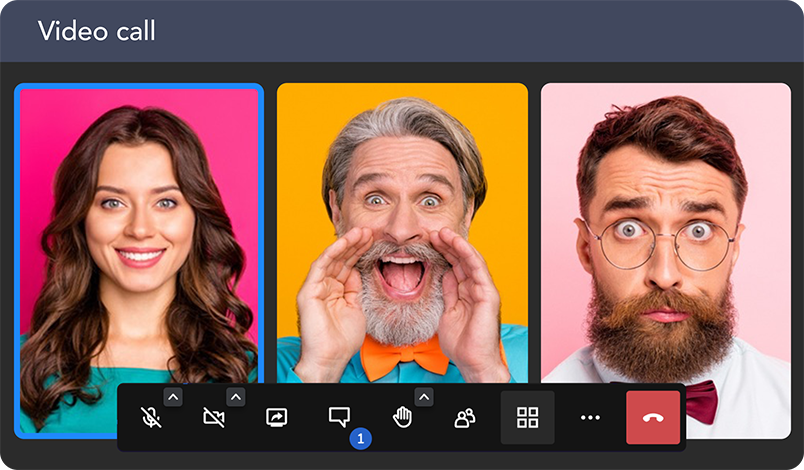In today’s fast-paced business world, technology has made it easier than ever for us to stay connected with each other, in real-time. Despite an abundance of communication tools at our disposal, it seems as though teams are becoming more and more fragmented. It doesn’t help that technology solutions, hoping to bridge this divide, are not really unifying teams. In order for teams to function at their best, members must all be on the same page.
When a small business team is not communicating effectively, it can lead to delays, missed deadlines, and other problems that can negatively impact the success of a project or business. Greasing the wheels of communication and promoting collaboration, however challenging in these times of remote workforces, is essential to managing an effective team. “Organizations that promote communication and collaboration are 4.5 times less likely to lose their best employees,” according to Teamstage.io. Keep reading as we dive into the components of what makes an effective team, the tools that unify team members, and how to continue supporting an effective team.

What makes an effective team?
An effective team is made up of unique individuals with different skill sets, experiences, and backgrounds–all working together to achieve a common goal. Team members should have respect for and trust for one another but also feel empowered to communicate openly, collaborate, and make decisions together. Let’s break down how each component of an effective team works.
Communication
Effective communication is the crux of everything that comes next. Clear, open, and timely communication allows for the free flow of information and ideas, the coordination of efforts, and ultimately, collaboration. Good communication also helps to foster trust and respect among team members, which are essential for effective teamwork and the success of an organization.
More often than not, especially with so much of the workforce being remote, online forms of communication have really taken centre stage. Having an open-door policy isn’t as simple as it used to be. Typically, communication channels included face-to-face meetings, but this is increasingly being replaced solely by video calls, instant messaging, and team chat apps. The trick is to find what works for your team and try to be consistent.
Collaboration
If a team consists of a diverse group of people, each with a unique set of skills, experiences, and perspectives; an organization could not thrive without their collaboration. Effective teams are able to come together and use each team member’s unique skills to achieve shared goals. Collaboration can be peer-to-peer, team brainstorming sessions, group projects, or even team-building exercises. “Nearly 75% of employees see teamwork and collaboration as essential,” according to Teamstage.io.
Having an open forum for team members to converse freely, encourages team members to speak openly about issues, concerns, or ideas they may have. Promoting different forms of collaboration also fosters work relationships or bonding that creates cohesion amongst team members. These initiatives will not go unnoticed, as studies show a direct correlation between work satisfaction and teamwork.
Decision making
An effective team is one that is capable of working together collaboratively, utilizing their diverse perspectives, and making decisions quickly. With open lines of communication and collaboration as the bedrock of a team, decision-making will come much more naturally.
Team members should be encouraged to share their ideas and opinions, and to actively listen to one another. Teams should also establish clear decision-making processes, such as consensus building, to ensure that all voices are heard and that decisions are made in a fair and pragmatic manner. Lastly, teams should have a platform for coming together and coming to a consensus, where everyone’s voice is heard and documented.
An effective team’s tools
The mark of a truly effective team is how well they can communicate and collaborate across a set of unifying tools. To facilitate this effective communication and collaboration, teams should make use of tools in the following areas: team messaging, task boards, design feedback, video calling, and document creation. These tools empower in-house and remote team members to stay organized, share ideas and resources, ask questions, and work together efficiently.
Team messaging
Team messaging apps are an essential tool for effective communication within a team, whether distributed or not. It allows team members to communicate in real-time, share ideas and resources, and stay updated on any latest team developments. Teams can utilize any number of messaging platforms, such as Slack, Microsoft Teams, or Discord. These apps allow for team discussions to be broken down into different channels or topics for organizational and reference purposes.
Task Boards
Organizing team priorities and assigning tasks, helps teams stay focused on what is important. Task boards allow team members to see what tasks need to be done, who is working on them, and what their progress is. There are numerous feature-rich tools available, such as Trello, Asana, or Jira. Task boards can be used to create different boards for different projects, while individual tasks can be added and assigned to team members on each board. Tasks boards are a great way to enable task-based team member collaboration.
Design feedback
Design feedback is an essential part of the design process, and it is important for teams to have a system in place for providing and receiving feedback. Online design platforms and collaboration tools have really proliferated over the last few years, so there are a lot of options to fit just about any team looking to incorporate design feedback into their workflow. Some tools currently available include InVision, Figma, and Zeplin. Design feedback can be done in real-time, and allows marketing teams to collaborate on design decisions and make sure that the final product meets the needs of the organization or the client.
Video calling

Video calls as a means to conduct business have exploded in recent years and have become a staple in the world of business communication. Video calling is essential for hybrid or fully remote teams, creating an environment of inclusion and connection. Not only are video calling services bridging the gap between face-to-face interactions, but they also enable teammates to share resources, chat, and even screen share. Video calls can be done through a variety of platforms, including Zoom, Skype, and Google Hangout.
Document creation
Whether your team is drafting proposals, project outlines, or marketing copy; having a collaborative environment to develop these documents should be part of any effective team’s strategy. There are several collaborative document creation services available, such as Google Docs, Microsoft Office, and Dropbox Paper. These tools allow team members to share documents, make changes, see revisions, and leave comments; all in real-time.
Team building
Building an effective team requires creating an environment where team members feel connected and a part of something bigger. Studies show a direct correlation between team-building initiatives and improvements in communication, as well as boosts to morale. Improvements in morale have been linked to boosts in productivity. It’s all very cyclical, yet most organizations often overlook this very simple practice. There are several initiatives your organization can take to start improving the work environment for your team, right now.
Show appreciation
Nothing encourages a member of your team to connect with your team and organization more than being acknowledged. Oftentimes, a team member will go to great lengths and even make sacrifices to meet a goal, and showing appreciation for that effort will keep your teammate wanting to be the best that they can be. Encouraging peer-to-peer acknowledgment and appreciation will foster a rewarding and worthwhile working environment that will reduce turnover and encourage productivity.
Encourage growth
Encourage your team to take on new, challenging tasks while supporting them with the necessary resources for them to learn and grow. Being able to expand their skills and knowledge as it relates to their job will help keep your team members from feeling like they’re in a rut or doing repetitive work. This growth potential has been proven to improve job satisfaction and reduce turnover rates dramatically.
Health and wellness
Let’s face it, the workplace can be a stressful environment from time to time, and it certainly is not as comfortable as our own home. Combat this by encouraging your team to stay healthy and fit by gamifying or setting goals that lead to small rewards. Simple, regular, team outings are a great way to promote positive physical health while also improving team interpersonal bonds.
Celebrate
We’re not talking about buying cheap pizza every so often to feign appreciation. We’re talking about building a culture of celebration that shows appreciation for team members’ commitments to the company. Celebrate birthdays, anniversaries, achievements, milestones, promotions, holidays, etc. The list can get long, but don’t let that discourage you from showing your team how much you appreciate them. If you have a remote team, be sure to make announcements in your team chat communications and consider ordering them lunch as a way to reach out and make your appreciation felt.

Conclusion
Effective teams are made up of unique individuals with different skills, experiences, and perspectives, who are all working toward a common goal. Effective communication, collaboration, and decision-making are key components of any effective team. The tools a team uses either improve the lives of your team members or make their lives harder. It’s important to find what works for your team and be consistent.
Remember, building an effective team doesn’t just stop at the communication and collaboration tools they use. It’s about creating a culture and engaging everyone in meaningful ways that make them feel a part of something bigger. Teamwork and collaboration are expected and provide a great work environment that reduces team turnover and helps you accomplish your business objectives.
————-
Heycollab is a project management tool built for teams like yours. With a free 14-day trial you can try out all the cool features. To get started visit https://heycollab.com/

